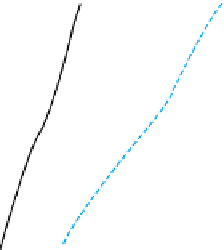Environmental Engineering Reference
In-Depth Information
10
1
0
0
5
10
15
20
25
30
35
40
45
50
k
~No maintenance
Poor maintenance
Fair maintenance
Perfect maintenance
Figure C.1. Recommended
k
s
values for unlined irrigation
canals as function of the water
depth
y
for various maintenance
conditions.
Constant km
because the expropriation costs will be less, the velocity is larger in a
deep canal than in a shallow canal and the sediment transport capacity is
larger in deeper canals (the transport capacity is linear with the bottom
width, but exponential with the water depth). To limit the excavation and
expropriation costs, the side slopes of a canal are designed as steep as
possible. Soil material, canal depth and the danger of seepage determine
the maximum slope of a side slope that is stable under “normal conditions”,
also against erosion. For deep excavations an extra berm can be included
to improve the stability of the slope. Table C.2 gives some recommended
values for the side slope.
Table C.2.
Side slopes in canals.
Material
m
Rock
0.0
Stiff clay
0.5
Cohesive medium soils
1.0-1.5
Sand
2.0
Fine, porous clay, soft peat
3.0
The top width of canal embankments depends on the soil type, the
side slope and special requirements in view of maintenance and operation.









































































Search WWH ::

Custom Search